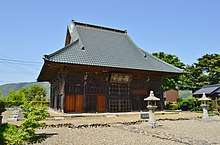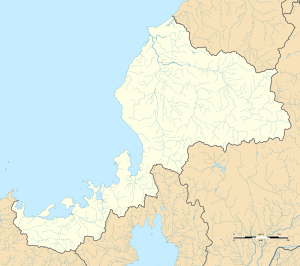Wakasa Kokubun-ji
Wakasa Kokubun-ji (若狭国分寺) is a Sōtō Zen Buddhist temple in Obama, Fukui, Japan. It is one of the few surviving provincial temples established by Emperor Shōmu during the Nara period (710 – 794).[1] Due to this connection, the temple grounds were designated as a National Historic Site by the Japanese government in 1976.[2]
| Wakasa Kokubun-ji 若狭国分寺 | |
|---|---|
 Wakasa Kokubun-ji Shaka-do | |
| Religion | |
| Affiliation | Buddhist |
| Rite | Sōtō Zen |
| Location | |
| Location | 51-1 Kokubun, Obama-shi, Fukui-ken |
| Country | |
 Shown within Fukui Prefecture  Wakasa Kokubun-ji (Japan) | |
| Geographic coordinates | |
| Architecture | |
| Founder | Emperor Shōmu |
| Completed | c.741 |
History
The temple is located on the alluvial plain of the Kitagawa River, approximately 4.5 kilometers east of the modern city centre of Obama. An excavation survey was conducted since 1972, indicating that the present temple overlaps the Nara period temple, which was built on a scale slightly smaller than other provincial temples. The exact date of construction is unknown, but is believed to be around 741 AD based on records indicating that the structures of Taikō-ji, pre-existing family temple of a local clan was relocated to this site to create the Wakasa Kokubun-ji. The original temple was rebuilt in the Heian period with a slightly different building plan, and in a record dating 1603, the date of construction is given as 807 AD. No roof tiles have been found at the site, which is unusual for a provincial temple. The temple is mentioned in Heian period and Kamakura period records, although mention of its associated provincial nunnery disappear after 1265 AD, and the exact site of the nunnery is now unknown.
In 1611, a Shako-dō was constructed on the site of the original Kon-dō. This building was rebuilt in 1705.
Precincts
The current precincts consist of the Shako-dō, a 5 x 5 bay building in the irimoya-style containing the temple's honzon Shaka Nyorai. Both the building and the statue are Obama City Designated Tangible Cultural Properties. To the west of the Shako-dō is the Yakushi-dō, containing a Yakushi Nyorai flanked by Shaka Nyorai and Amida Nyorai. The Edo period Yakushi Nyorai is from the now-vanished provincial nunnery, and is a National Important Cultural Property.[3] The other two statues are both Obama City Designated Tangible Cultural Properties.
Also within the grounds is a large circular kofun tumulus, with a diameter of approximately 50 meters. One of the largest in the Wakasa region, it dates from the 6th century.
References
- "Kokubunji". Encyclopedia of Japan. Tokyo: Shogakukan. 2012. Archived from the original on 2007-08-25. Retrieved 2012-05-04.
- "若狭国分寺" (in Japanese). Agency for Cultural Affairs.
- "若狭小浜のデジタル文化財" (in Japanese). City of Obama.
External links
| Wikimedia Commons has media related to Wakasa Kokubunji. |
- Fukui Prefectural Cultural Sites (in Japanese)
- Obama City official home page (in Japanese)
- Cultural sites in Wakasa Province